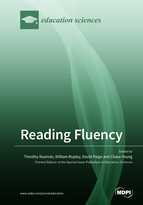Reading Fluency
A special issue of Education Sciences (ISSN 2227-7102).
Deadline for manuscript submissions: closed (15 January 2020) | Viewed by 79784
Special Issue Editors
Interests: reading fluency and word study; reading in the elementary and middle grades; readers who struggle
Special Issues, Collections and Topics in MDPI journals
Interests: reading acquisition and development; reading assessment and correction; reading comprehension development and text processing; reading in science and mathematics
Special Issues, Collections and Topics in MDPI journals
Interests: reading fluency; foundational skill development; assessment; development of teacher capacity and the quality improvement of reading instruction across schools and districts
Special Issue Information
Dear Colleagues,
William Rupley, David Paige, Chase Young and I are guest-editing a Special Issue of Education Sciences that will focus on reading fluency and reading fluency instruction. We are looking for both empirical research and conceptual pieces that advance our thinking in how fluent reading develops in children and how we might best nurture students’ fluency development through instruction.
Fluency has been a controversial topic for years. Allington described it as a neglected goal of the reading curriculum in 1985. The National Reading Panel (2000) provided empirical evidence of its importance in reading development. Measurement approaches to fluency have given rise to fluency as nothing more than fast reading, and recent surveys of experts in the field have consistently identified reading as a “not hot” issue and one that does not deserve to be hot. Based on our own research and interest in fluency, as well as work by other scholars, we are convinced that fluency is a critical competency for readers to gain full reading proficiency. Given your own interest and expertise in this area we are delighted to invite you to submit an article for this issue. We define the theme for this issue, Reading Fluency, in rather broad terms. It can encompass conceptualizing reading fluency, fluency development at various ages, assessing and measuring fluency, and effective fluency instruction.
Articles should be in the range of 20–30 pages including references (double-spaced) with a due date of January 15, 2020 for publication in spring or summer 2020. You may include co-authors if you wish. If you think you are interested and able to contribute to this issue of Education Sciences, please respond back to us within two weeks and also include a brief description and title of your article.
Thank you for your consideration of this invitation. Best wishes and looking forward to hearing from you shortly,
Prof. Dr. Timothy Rasinski
Prof. Dr. William Rupley
Prof. Dr. David Paige
Prof. Dr. Chase Young
Guest Editors
Manuscript Submission Information
Manuscripts should be submitted online at www.mdpi.com by registering and logging in to this website. Once you are registered, click here to go to the submission form. Manuscripts can be submitted until the deadline. All submissions that pass pre-check are peer-reviewed. Accepted papers will be published continuously in the journal (as soon as accepted) and will be listed together on the special issue website. Research articles, review articles as well as short communications are invited. For planned papers, a title and short abstract (about 100 words) can be sent to the Editorial Office for announcement on this website.
Submitted manuscripts should not have been published previously, nor be under consideration for publication elsewhere (except conference proceedings papers). All manuscripts are thoroughly refereed through a double-blind peer-review process. A guide for authors and other relevant information for submission of manuscripts is available on the Instructions for Authors page. Education Sciences is an international peer-reviewed open access monthly journal published by MDPI.
Please visit the Instructions for Authors page before submitting a manuscript. The Article Processing Charge (APC) for publication in this open access journal is 1800 CHF (Swiss Francs). Submitted papers should be well formatted and use good English. Authors may use MDPI's English editing service prior to publication or during author revisions.
Keywords
- Reading Fluency
- Word Recognition Automaticity
- Prosody
- Reading Rate







